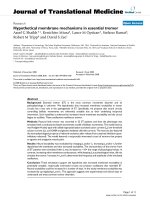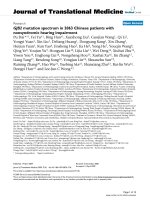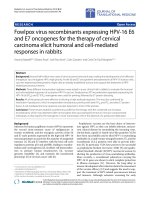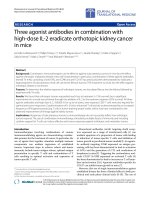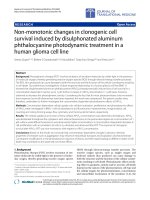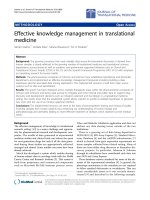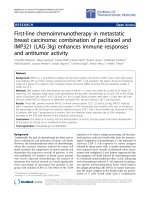báo cáo hóa học:" Medical work Assessment in German hospitals: a Real-time Observation study (MAGRO) – the study protocol" doc
Bạn đang xem bản rút gọn của tài liệu. Xem và tải ngay bản đầy đủ của tài liệu tại đây (286.2 KB, 5 trang )
BioMed Central
Page 1 of 5
(page number not for citation purposes)
Journal of Occupational Medicine
and Toxicology
Open Access
Study protocol
Medical work Assessment in German hospitals: a Real-time
Observation study (MAGRO) – the study protocol
Stefanie Mache*
1,2
and David A Groneberg
†1
Address:
1
Institute of Occupational Medicine, Charité – School of Medicine, Free University and Humboldt University, Thielallee 69-73, 14195
Berlin, Germany and
2
Department of Medicine/Psychosomatics, Charité – School of Medicine, Free University and Humboldt University,
Luisenstrasse 13a, 10117 Berlin, Germany
Email: Stefanie Mache* - ; David A Groneberg -
* Corresponding author †Equal contributors
Abstract
Background: The increasing economic pressure characterizes the current situation in health care
and the need to justify medical decisions and organizational processes due to limited financial
resources is omnipresent. Physicians tend to interpret this development as a decimation of their
own medical influence. This becomes even more obvious after a change in hospital ownership i.e.
from a public to a private profit oriented organization. In this case each work procedure is revised.
To date, most research studies have focused mainly on differences between hospitals of different
ownership regarding financial outcomes and quality of care, leaving important organizational issues
unexplored. Little attention has been devoted to the effects of hospital ownership on physicians'
working routines.
The aim of this observational real time study is to deliver exact data about physicians' work at
hospitals of different ownership.
Methods: The consequences of different management types on the organizational structures of
the physicians' work situation and on job satisfaction in the ward situation are monitored by
objective real time studies and multi-level psycho diagnostic measurements.
Discussion: This study is unique in its focus. To date no results have been found for computer-
based real time studies on work activity in the clinical field in order to objectively evaluate a
physician's work-related stress. After a complete documentation of the physicians' work processes
the daily work flow can be estimated and systematically optimized. This can stimulate an overall
improvement of health care services in Germany.
Background
The current situation for ward physicians working in
German hospitals
The German health care system is undergoing substantial
changes in terms of general medical supply in hospitals
and outpatient clinics and the role of public health insur-
ance. Currently hospitals are dealing with declining finan-
cial support. Because of this there is a higher doctor-
patient ratio, recently introduced work time schedules
and a decrease in personnel expenditure.
Published: 8 June 2009
Journal of Occupational Medicine and Toxicology 2009, 4:12 doi:10.1186/1745-6673-4-12
Received: 20 April 2009
Accepted: 8 June 2009
This article is available from: />© 2009 Mache and Groneberg; licensee BioMed Central Ltd.
This is an Open Access article distributed under the terms of the Creative Commons Attribution License ( />),
which permits unrestricted use, distribution, and reproduction in any medium, provided the original work is properly cited.
Journal of Occupational Medicine and Toxicology 2009, 4:12 />Page 2 of 5
(page number not for citation purposes)
After the implementation of structured and more formal-
ized treatment procedures, quality of care and economic
aspects should improve. But for physicians it is becoming
increasingly difficult to treat patients adequately. The
aforementioned framework has a tremendous influence
on every day medical services. Individual medical treat-
ment of patients is becoming increasingly unusual under
the current circumstances. How much time is spent on
non-medical issues such as administrative work is not
clear because only subjective data is available.
Many doctors complain about their current work situa-
tion [1]. The most frequent complaints include: working
overtime, doing extended shift work and on-call duties at
short notice, missing internal coordination and commu-
nication of working routines and increasing administra-
tive and documentations tasks are named most frequently
[2].
Further reasons for physician dissatisfaction are enor-
mous workloads leading to massive time pressure and
decreased treatment periods [3-5]. More work strain is to
be expected due to staff cuts and thus an increase in work
intensity. Work obstacles such as incomplete patient doc-
umentation and constant interruptions lead to a deterio-
ration of medical tasks [3,4].
Occupational safety problems were primarily found in the
field of accident risk or exposure to noise or chemical con-
tamination. This situation has now changed and physi-
cians are more at risk of suffering from psychological
stress than other factors [3,4].
A further problem concerns work time organization.
According to a study of the German Institute for Econom-
ics (2003), young physicians work 55.3 hours on average
per week. Only 40% of German hospitals introduced new
work time models [6] after the judgment of the European
Union from 9 September 2003 which refers to the prob-
lematic situation of the medical profession in German
hospitals. Long working hours not only have an effect on
physicians' work and their well-being but also on the
quality of patient care.
Research results clarify that it is becoming increasingly
important to analyze the workflow in hospitals objec-
tively and precisely. Nevertheless, at this time, heavy
workloads are generally accepted and objective task anal-
yses are not being carried out. So far analyses on this topic
were based on questionnaires and statements of physi-
cians [4]. However it can be assumed that there is a possi-
ble discrepancy between the results of objective and
subjective observation [7].
Consequences of hospital privatization on the
occupational situation of physicians
Until recently hospitals were predominantly publicly
owned. This has changed dramatically in the recent past.
There is a tendency toward privatization in our society
and hospitals are no exception [8].
Privatization may have, but does not necessarily have to
have an influence on workload. The actual effect on work
conditions is hard to estimate and is, therefore, the aim of
this study. In a report published by The German Physi-
cians' Union results were not consistent [9].
Currently no scientific results either related to the profes-
sional situation after privatization or general changes in a
physician's work role have been found. This study plans to
close the gap.
The German Medical Association claims to have carried
out a more qualitative analysis of privatized hospitals in
2007 [9]. Comparisons beyond economic data are greatly
needed. Variables that should be researched are the qual-
ity of workflow, patient satisfaction, amount of sick leave,
and the fluctuation of employees.
Job task analysis method
To evaluate work flow quantitatively an empirical meas-
urement is needed. Usually a job task analysis is utilized.
The general purpose of job task analysis is to document
the requirements of a job and the work performed. Task
analysis is performed as a basis for later improvements
including: definition of a job domain, developing per-
formance appraisals, selection systems, training needs
assessment, and compensation plans [10].
The method is defined by an exact observation of every
single activity within a given period. Originally a stop-
watch, paper and pencil were utilized. To ensure a smooth
procedure and a better comparability as well as a subse-
quent legibility of observed tasks, symbolization was
introduced to represent certain events and to create a sys-
tem of categories. These patterns are the most important
qualitative basis for this analysis.
Some of these techniques are more focused on recording
body positions and movements, such as the WinOWAS
[11], TRAC (Task Recording and Analysis on Computer
[12] or PEO (Portable Ergonomic Observation Method
[13]. The current procedure is to connect the protocol to
electronic data software programs. This allows repeated
inspection and further data analysis. The calculation of
statistical parameters and graphic models are easily car-
ried out.
Journal of Occupational Medicine and Toxicology 2009, 4:12 />Page 3 of 5
(page number not for citation purposes)
Further improvements of such methods will be included
in this study:
• Definition of a system of categories for the physician's
task analysis
• Creation of a user-friendly interface
• Improvement in the mode of interaction during the
recording procedure
Aims and objectives
Research and health-political significance
The overall aim of this real-time study is to evaluate exact
data relating to work.
A short term goal of the investigation is to provide refer-
ential values of different medical specialties in order to
define accurate job task profiles of different physician
groups. In order to achieve an effective comparison of the
groups, physicians with similar specialties should be
included, but working in hospitals of different ownership
(e.g., private vs. public).
In the context of the investigation a multimodal diagnos-
tic measurement is to be used to evaluate physicians' work
load and demands. In order to reduce psychological and
physical demands effectively, it is necessary to identify
ranges of stress.
On one hand, objective workloads must be determined
independent of the physicians' subjective perception. On
the other hand, personal points of view must be brought
into focus by asking how specific job characteristics influ-
ence a physician's well being and job satisfaction as well
as what kind of social and organizational resources might
have a positive effect on managing work load.
In the context of the monitoring the following main ques-
tions need to be answered.
1. Do significant differences exist regarding the organiza-
tion of work flow between physicians of the same medical
discipline, but from hospitals of different ownership?
2. Do different work and organization models have effects
on the occupational situation (job demands, state of
health) and work satisfaction of physicians?
3. What kinds of workload factors can be observed when
comparing different work and organization models?
4. Do specific factors exist that have a substantial influ-
ence on a physician's job satisfaction?
5. Do occupational resources have an impact on the abil-
ity to work?
6. Do work obstacles which have an influence on physi-
cians' work situation and job satisfaction exist?
Development of a work assessment method to evaluate
physicians' workflow
Exclusive observations and questioning would increase
the danger of incorrectly evaluating work conditions and
of insufficiently addressing the actual work situation.
With the help of a computer-based recording methodol-
ogy, a possibility is given to counteract this bias. Therefore
detailed computer-based task observations should be
implemented in the work analysis.
Keeping that in mind, the second aim of this study is to
examine and to develop computer software. Thus a pro-
gressive work analysis procedure could be available for
further research. This study will focus on the following:
• The procedure which considers different areas of a
physicians' work situation in hospital departments
(work flow, organizational aspects, etc.).
• The procedure which can be implemented in differ-
ent medical specialties (e.g., Internal medicine, Neu-
rology, Pediatrics, etc.) and hospital types (public,
private hospitals, etc.).
Methods
Sample and Recruitment
Physicians of different medical specialties will be included
in the study (i.e., Neurology, Psychiatrics, Surgery, Pediat-
rics, Internal medicine). In addition, they will be recruited
from hospitals of different ownership types (private for-
profit, private non-profit, public) (Fig. 1).
After the research group will have had contacted hospital
supervisors, a selection of physicians will take place on a
voluntary basis. The comparative samples are composed
of physicians of the same medical specialty; however, they
work at hospitals of different ownership. A satisfactory
comparability of the groups will thus be achieved.
Instruments
Objective task-analysis
Objective task analysis is based on data of physicians'
work in hospital departments.
The data of the study will represent the basis for load anal-
yses. Only via objective task analyses can a differentiation
be made among the participating physicians with regard
to their affiliation with very stressful or less stressful jobs.
Journal of Occupational Medicine and Toxicology 2009, 4:12 />Page 4 of 5
(page number not for citation purposes)
With the help of the developed activity acquisition pro-
gram workflow can be registered objectively by mobile
computer-based collection equipment (Ultra Mobile PC)
(Fig. 2).
The analytical apparatus can be carried in one hand and
possesses a touch screen. By touching the surface of the
mobile computer an exact time is registered.
When the assessment is complete, data will be transferred
to another PC and evaluated statistically and graphically:
the number of individual occurrences of each task, mean
duration of each occurrence, the total time (in seconds)
spent on each task, task category, and the time expendi-
ture for all tasks will be counted.
To collect meaningful information about physicians'
workflow at least 20–30 physicians per medical specialty
should be observed during an entire work week. Individ-
ual weekdays should be represented equally, so that a
comparison of the medical activity is possible for all week-
days.
Afterwards the collected data can be interpreted as referen-
tial values for the physicians' work. Early and late shifts
are equally represented.
During the task analysis the following aspects should be
registered:
• The kind of work activity
• Duration and frequency of the tasks
• Work environment (lighting, room temperature, noise
level)
• Interruptions (frequency, duration, type)
• Rest periods (time, duration, location)
Study DesignFigure 1
Study Design.
Ultra Mobile ComputerFigure 2
Ultra Mobile Computer.
Publish with BioMed Central and every
scientist can read your work free of charge
"BioMed Central will be the most significant development for
disseminating the results of biomedical research in our lifetime."
Sir Paul Nurse, Cancer Research UK
Your research papers will be:
available free of charge to the entire biomedical community
peer reviewed and published immediately upon acceptance
cited in PubMed and archived on PubMed Central
yours — you keep the copyright
Submit your manuscript here:
/>BioMedcentral
Journal of Occupational Medicine and Toxicology 2009, 4:12 />Page 5 of 5
(page number not for citation purposes)
A questionnaire study on perceived job demands and work stress
In addition to the above a comparison analysis is to be
carried out regarding objective and subjective perception
of the work situation. Since workload can only be deter-
mined and judged by the coworkers themselves, physi-
cians will be asked to fill out a questionnaire, which
includes questions on each individual's perception of
their work conditions and workload.
The German version of the Copenhagen Psychosocial
Questionnaire (COPSOQ) will be used to assess job-
related factors at work [14]. Various aspects of work, for
example, job demands (e.g., quantitative demands); job
resources (i.e., quality of leadership, social support) as
well as job outcomes (i.e., state of health) are captured by
the COPSOQ. The version used in this survey comprised
16 scales [14].
The questionnaire will be presented as a pencil-and-paper
version. Physicians will be requested to post it in a box
placed in their departments within three weeks.
Statistical data analysis
The following statistical analysis will be carried out
dependent on the hypotheses:
descriptive statistics and ANOVAs will be calculated to
examine whether there are differences in work conditions
as well as in job satisfaction between the three ownership
types.
Hierarchical regression analysis will be used to analyze
the degree to which job satisfaction can be explained by
physicians' job demands and resources. To examine the
differences in the effects of job demands and resources
between the hospitals, separate analyses will be per-
formed for each type of hospital ownership.
All p-values given will be two-tailed. A p-value of less than
.05 will be considered significant. Values will be given as
mean and standard deviation (SD). Data will be calcu-
lated using the SPSS
®
software package for social sciences;
Version 17.0.
Discussion
At this time no results have been found for computer-
based real time studies on work activity in the clinical field
in order to objectively evaluate a physician's work-related
stress.
It is a central and a long-term goal to develop possibilities
for improvements to optimize physicians' work flow.
Reorganization of work flow should lead, for example, to
a respite from non-medical tasks. Periods of high work-
load, which lead to an additional burden, can thus be
avoided. As a result the physician's job satisfaction will be
increased and better patient care can be ensured. All
things considered, this study can stimulate an overall
improvement of health care services in Germany.
Competing interests
The authors declare that they have no competing interests.
Authors' contributions
SM and DAG conceived and designed the study. SM wrote
the manuscript. SM and DAG contributed substantially to
its revision.
References
1. Jurkat HB, Reimer C: Arbeitsbelastung und Lebenszufrieden-
heit bei berufstätigen Medi-zinern in Abhängigkeit von der
Fachrichtung. Schweizerische Ärztezeitung 2001, 82:1745-1750.
2. Ulich E: Arbeitspsychologie in Krankenhaus und Arztpraxis. Arbeitsbedin-
gungen, Belastungen, Ressourcen Bern: Verlag Hans Huber; 2003.
3. Herschbach P: Psychische Belastung von Ärzten und Krankenpflegekräften
Weinheim: VCH Verlagsgesellschaft; 1991.
4. Peter S, Ulich E: Analyse der Arbeitssituation von Assistenz-
und Oberärztinnen und -ärzten: Erfahrungen aus zwei Pro-
jekten. In Arbeitspsychologie in Krankenhaus und Arztpraxis Arbeits-
bedingungen, Belastungen, Ressourcen Edited by: Ulich E. Bern: Verlag
Hans Huber; 2003:75-98.
5. Stern K: Ende eines Traumberufs? Lebensqualität und Belastungen bei Ärz-
tinnen und Ärzten Münster: Waxmann Verlag; 1996.
6. Rieser S: Noch kein Problem gelöst. Deutsches Ärzteblatt 2006,
103(39):2821.
7. Ulich E: Arbeitspsychologie Volume 6. Zürich: Schäffer-Poeschel; 2005.
8. Rudolphi M: Folgen der Privatisierung von Krankenhäusern:
Die Spielregeln sind willkürlich. Deutsches Ärzteblatt 2007,
104(27):A-1956 / B-1728 / C-1664.
9. Henke R, Stüwe U, Montgomery U: Zunehmende Privatisierung
von Krankenhäusern in Deutschland. 2007.
10. Cascio WF, Aguinis H: Applied Psychology in Human Resource
Management. 6th edition. Prentice Hall; 2005.
11. Kivi P, Mattila M: Analysis and improvement of work postures
in the building industry: application of the computerized
OWAS method. Applied Ergonomics 1991, 22(1):43-48.
12. Beek AJ Van der, Van Gaalen L, Frings-Dresen H: Working pos-
tures and activities of lorry drivers: a reliability study of on-
site observation and recording on a pocket computer. Applied
Ergonmics 1992, 23(5):331-336.
13. Fransson-Hall C, Gloria R, Kilbom A, Winkel J, Karlqvist L, Wiktorin
C: A portable ergonomic observation method (PEO) for
computerized on-line recording of postures and manual han-
dling. Applied Ergonomics 1995, 26(2):93-100.
14. Nübling M, Stößel U, Hasselhorn H-M 3, Michaelis M, Hofmann F:
Measuring psychological stress and strain at work. GMS Psy-
cho-Social-Medicine 2006, 3:.

